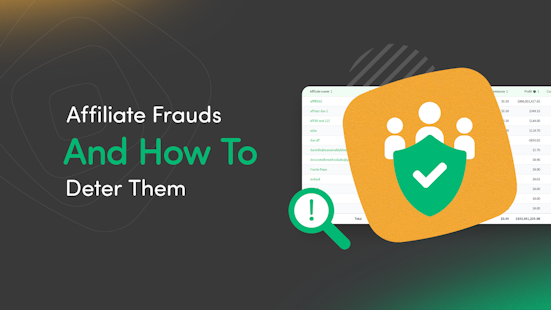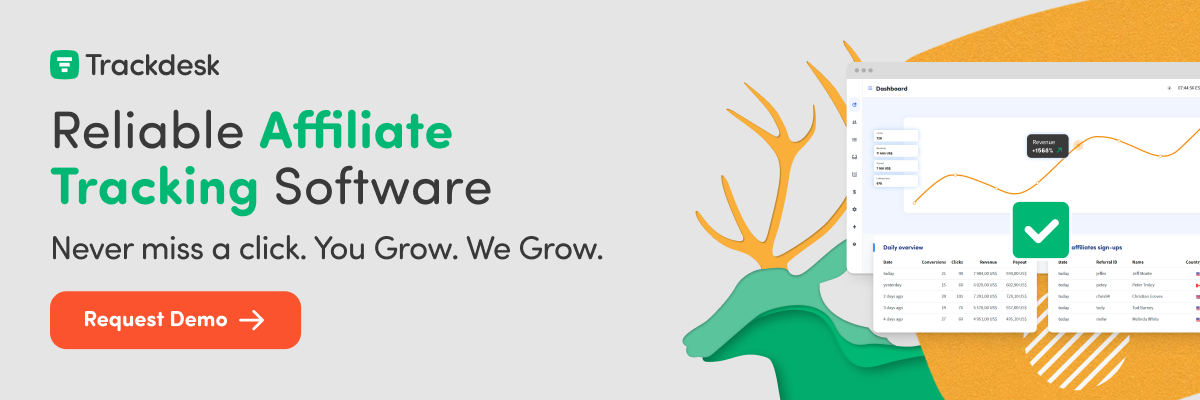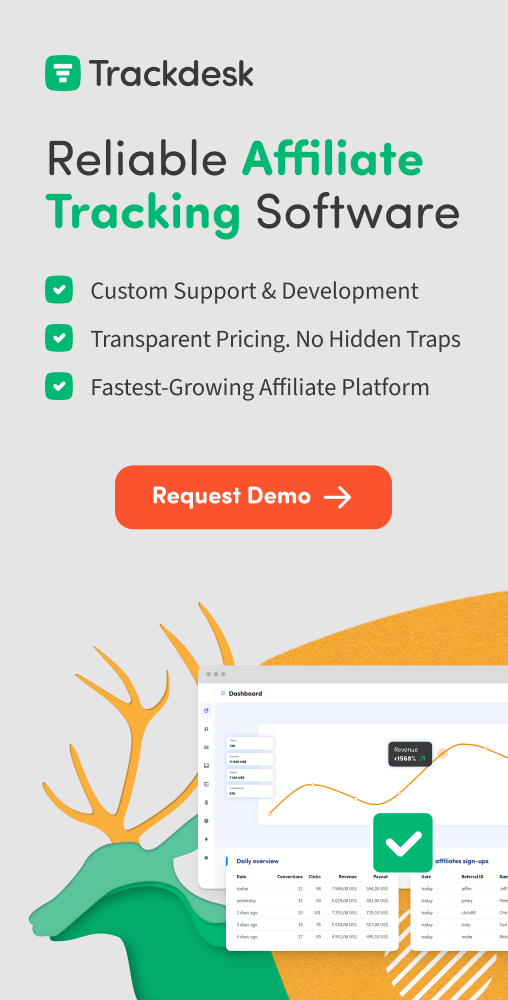
Prevent Affiliate Frauds: 7 Effective Strategies
Discover how to protect your affiliate marketing program. Find out 7 proven strategies to stop common frauds and improve your performance with trackdesk.
8 Common Affiliate Frauds And 7 Proven Strategies To Deter Them
The world of affiliate marketing is abundant with opportunities but is clouded by a significant threat: affiliate fraud. This problem can endanger a company’s financial stability, brand reputation, and legal status. Additionally, the complexities of affiliate marketing often leave newcomers questioning its legitimacy, further complicating matters.
Recent data reveals that 17% of the traffic coming from affiliate programs is fake, resulting in substantial annual losses in this billion-dollar industry. Beyond financial strain, affiliate fraud inflicts severe reputational harm, eroding trust when customers fall victim to fraudulent transactions. Legal consequences loom for businesses neglecting fraud prevention.
The good news is that you can deter these fraudulent activities. Empower yourself with knowledge and proactive measures. Understand common fraud tactics that you can use as your primary defence. Robust affiliate marketing software with an affiliate fraud prevention feature, like trackdesk, can be a game changer, alerting businesses about potential issues.
8 Common Types of Affiliate Marketing Fraud
As affiliate marketing grows, so does the risk of fraud. Learn to spot fraud indicators and use effective affiliate fraud prevention strategies to safeguard your affiliate program.
-
Click Spoofing
Click spoofing is a fraudulent act that manipulates the affiliate marketing system, creating false clicks that trigger undeserved commission payouts for sales they never generated. Click spoofing exploits system vulnerabilities, using bots, compromised devices, or deceptive software to produce inflated click counts, misleading performance metrics, and unwarranted payouts.
-
Click Fraud
Click or bot fraud deliberately produces false clicks on affiliate links using emulators and botnets, often targeting the Cost-Per-Click space. These bot-generated clicks can even extend to fabricating social media engagement, perpetuating influencer fraud. Unlike click spoofing, click fraud falsely drives real user traffic, artificially inflating click counts on PPC ads. The goal is to deplete a competitor’s budget, resulting in wasted funds and skewed data.
An infamous case in 2016 revealed ‘Methbot,’ a Russian fraud ring that generated $3 million to $5 million daily through fake clicks on video ads. They established over 6,000 domains and 250,267 distinct URLs, creating an elaborate network seemingly linked to major publishers.
-
Cookie Stuffing
Cookie stuffing, or cookie dropping, is a deceptive tactic that puts cookies on a user’s device without consent to trick websites into thinking fraudulent affiliates generated traffic. Black hat marketers use this method to mislead websites into awarding undeserved commissions. The fraudster aims to make the website believe the user acted (like signing up or purchasing) due to the affiliate’s influence. Cookie stuffing relies on sheer numbers, affecting every visitor to the site. While there are ways to clear browser cookies on a device, the average person is unaware of them or doesn't bother removing the cookies in the first place.
Fraudsters can insert cookies into a browser via pop-ups, hidden iframes, invisible images, and malicious JavaScript. This unethical practice violates affiliate program terms; in some jurisdictions, like the US, it’s deemed illegal. A good example is the eBay scam involving top affiliates Shawn Hogan and Brian Dunning, who were convicted of making over $28 million through cookie-stuffing widgets, emphasising the legal consequences of such actions.
-
Hidden Landing Pages
Hidden landing pages operate covertly, diverting users from your intended destination to benefit unscrupulous affiliates. These concealed gateways aim to drive traffic to unauthorised landing pages, often using keyword-rich content to manipulate search engine rankings. This fraudulent practice not only deceives search engine algorithms but also creates a subpar user experience. Since the rise of advanced multi-click cloaking techniques, detecting hidden landing pages has become even more challenging.
-
URL Hijacking or Sneaky Redirects
URL hijacking, also known as sneaky redirects, diverts user traffic, steals conversion credit, and compromises your affiliate program’s integrity. The fraudster achieves this by swapping the affiliate ID, ensuring sales through the hijacked link benefit them. It’s a “bait-and-switch” for traffic, risking the rightful affiliate’s commission. Fraudsters may also create fake sites resembling your brand, redirecting customers to earn commissions from affiliate partners.
-
Malware
Malware, short for malicious software, is a grave threat in affiliate marketing, encompassing software designed to harm computers, servers, or networks. Within affiliate marketing, fraudsters employ malware to manipulate tracking data, steal information, and divert conversions.
For instance, adware, a type of malware, delivers intrusive ads and redirects users, stealing commissions. Spyware gathers information without consent, risking personal data theft. Trojans mislead users and create security backdoors, compromising sensitive data. Then, though not as common, ransomware encrypts data, demanding a ransom.
-
Using Stolen Data
Utilising stolen data for affiliate fraud involves exploiting compromised user information, login credentials, or credit card data to make unauthorised purchases through affiliate links. This not only diverts commissions but also tarnishes the integrity of your program. To protect sensitive information and reduce the risks of affiliate fraud, many users look for alternatives to Proton that offer secure email, encryption, and privacy-focused tools to keep their data safe.
Deceptive affiliates use stolen data in various methods. Alongside cookie stuffing, the most common practices include ad stacking and domain spoofing. Ad stacking involves using multiple hidden ads to register clicks deceitfully. In domain spoofing, fraudsters create fake websites resembling legitimate ones, using stolen data to make them appear genuine. These fraudulent sites are then exploited to generate deceptive traffic and commissions. To prevent misuse of sensitive data, it's important to track and secure all devices accessing affiliate platforms. Implementing computer inventory software can help ensure only authorized devices have access to critical affiliate and customer information, adding an additional layer of protection against fraud.
-
Malvertising
Malvertising, a malicious fusion of “malware” and “advertising,” inserts harmful code into legitimate online ads. This hidden threat resides within seemingly innocuous banners, pop-ups, or video ads ready to initiate various harmful activities on users’ devices. Scammers exploit malvertising by buying ad space on other websites and deploying ads with infected code. Clicking on these ads not only downloads a virus onto the user’s device but also sets a cookie, enabling scammers to earn commissions from subsequent purchases. If you suspect a virus infection, a dedicated Mac cleaner can help you remove junk, delete malware, and uninstall suspicious software all within one app.
The danger of malvertising lies in its ability to impact reputable websites, as they often rely on third-party ad networks, which may unintentionally display malicious ads. Users can contract malware simply by visiting a site containing these harmful ads, even without interacting directly with the ad itself. To stay safe, it’s wise to combine basic precautions with security tools like a VPN for Mac, which helps mask your online activity and block some malicious connections before they reach your device.
6 Ways to Prevent Affiliate Fraud
In addition to routine checks on affiliate program performance and implementing safeguards like commission caps and thresholds to control payouts during irregular activities, here are strategies to prevent affiliate fraud.
-
Define Clear Affiliate Terms and Conditions
Protecting your affiliate program from fraudulent activity starts with a solid foundation: comprehensive and transparent affiliate program Terms and Conditions (T&Cs). These T&Cs clearly outline acceptable promotional practices, explicitly prohibit methods such as utilising stolen data, and outline consequences for non-compliance.
One fraudulent practice typically prohibited in an affiliate program T&C is brand bidding. It violates trademark law and can lead to lost sales and revenue, as it diverts traffic from a brand's website to an affiliate's.
To prevent affiliates from engaging in brand bidding, use clear and direct language in your T&C. Regularly update your terms and conditions to align with industry best practices and evolving threats. Simplify this process with trackdesk, which offers customisable T&C templates. Easily add or delete practices to tailor terms to your program's specific needs.
-
Take Proactive Measures
To thwart affiliate fraud proactively, go beyond reactive measures. Conduct an IP analysis, ensuring the user’s IP aligns with the affiliate’s location. Monitor connection attempts, signup form speed, and watch for sudden traffic spikes, especially from suspect IPs or low-conversion regions. Use reliable sources like click fraud detection tools and industry blacklists to identify fraudulent IPs accurately. Invest in solid IP address management to track user behavior, detect anomalies, and act quickly on suspicious activity.
You can also implement CAPTCHAs or double opt-in procedures to deter automated click bots and verify real user clicks. Enforce a comprehensive domain whitelisting strategy to enhance program security, prevent unauthorised redirects, and preserve campaign integrity. Regularly update exclusion lists to stay ahead of evolving threats. Remember that partnering with reliable platforms is crucial. By integrating the best affiliate network software, like Trackdesk you can effectively lower the risk of affiliate fraud thanks to it's built-in fraud prevention features.
-
Monitor Traffic Regularly
Continuous traffic monitoring acts as an ever-watchful sentinel, scrutinising every click, conversion, and interaction in your program. This vigilant observation enables real-time anomaly detection, unveiling sudden spikes in clicks from dubious locations or unrealistic conversion rates from specific affiliates. Whether dealing with automated bot activity, hidden redirects, or unauthorised traffic sources, continuous monitoring sheds light on potential fraud before it infiltrates your network.
-
Establish Effective Communication with Partners
Cultivating trust and encouraging transparent communication in your affiliate network is not just a courtesy; it’s a potent tool against fraud. Establish clear, two-way communication channels with your partners, urging them to report suspicious activity. Whether it’s unusual traffic patterns or questionable practices by other affiliates, creating a collaborative atmosphere where information flows freely empowers partners to act as an extended security team, actively aiding in identifying and preventing fraudulent attempts.
Effective communication is a crucial aspect of trackdesk. Alongside its robust affiliate management capabilities, it incorporates communication features and tools such as newsletters, ensuring everyone stays informed about the latest affiliate-centric news, including fraudulent activities.
-
Avoid Auto-Approval of Affiliates
Resisting the temptation of quick expansion through auto-approving affiliates is vital in securing your program against fraud. While auto-approval may seem convenient, it exposes your network to potential malicious actors seeking illegitimate gains. Prioritise a thorough vetting process, investing resources in background checks to verify potential affiliates’ legitimacy and ethical practices. Analyse their website traffic, conversion rates, and past performance in other programs.
Careful vetting ensures the selection of trustworthy partners aligned with your brand values, contributing to the long-term success of your program. Remember that a brief onboarding delay is a small price for a secure and thriving affiliate network.
-
Partner with a Trustworthy Affiliate Marketing Platform
The affiliate marketing industry abounds with platforms facilitating connections to affiliate partners. However, opting for this route demands considerable time and resources. Optimise your approach by selecting a platform that connects you directly with affiliate partnership managers who can streamline, automate, and simplify the entire process for you.
One such platform is trackdesk’s Partnership Managers Marketplace, which provides a secure environment, connecting you with verified professionals recognised for ethical practices. This proactive approach reduces fraud risk, as experienced managers can spot suspicious activity. Investing in this robust platform that fosters lasting partnerships with proven professionals allows you to concentrate on long-term success and brand loyalty with a fraud-free reputation.
Combatting Affiliate Fraud: A Call to Vigilance
Despite the numerous benefits of affiliate marketing, it's wise to be mindful of its challenges, such as concerns related to affiliate fraud. We’ve delved into eight prevalent threats, ranging from click spoofing to malvertising, all seeking to divert your hard-earned revenue. Yet, armed with knowledge and implementing the six potent strategies outlined, you can establish a solid defence.
Constant vigilance is key to protecting your program against the new tactics of affiliate fraud. Work with platforms like trackdesk, which has stringent security measures and a set of rules capable of identifying potential fraud. Users are promptly notified when a rule is triggered, allowing them to take immediate action. You can foster a thriving affiliate network grounded in transparency, trust, and mutual success through collaboration with trusted allies and steadfast commitment to ethical practices.

I have a passion for storytelling. I believe that a good story delivers value while capturing, influencing, and sustaining its intended audience. This has always been, and always will be, my primary aim as a writer.


